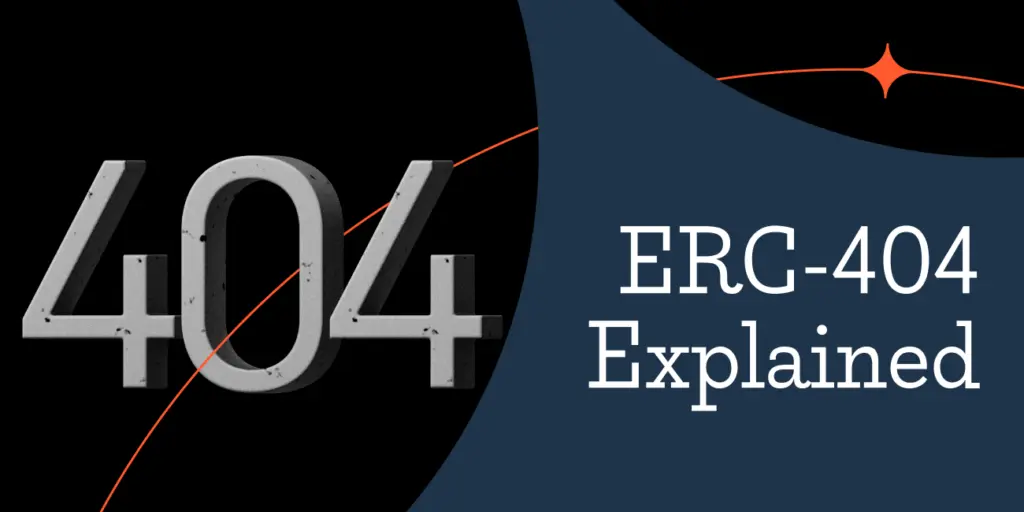
Non-fungible tokens (NFTs) have been one of the biggest developments in the crypto industry, bringing millions of money and people to the digital art, collectables, gaming, and metaverse sectors.
However, NFTs also have several constraints, such as high transaction costs, poor liquidity, and lack of interoperability. To solve these difficulties, a new token standard has arisen on the Ethereum blockchain called ERC-404. This standard combines the properties of fungible tokens (FTs) and NFTs, providing a new form of token that may be both fungible and non-fungible, depending on the use case.
Today we analyze what ERC-404 is, how it works, what are its pros and limitations, and if you should invest in it or not.
What is ERC-404?
-
ERC-404 is an experimental token standard based on the Ethereum blockchain that intends to integrate the features of ERC-20 tokens (fungible tokens) and ERC-721 tokens (non-fungible tokens, or NFTs) into a single standard.
-
This means that ERC-404 tokens can be both fungible and non-fungible, depending on the individual implementation. For example, a token can start as an FT and be traded with other tokens of the same sort without losing any value, but once it is used or redeemed, it can become an NFT and obtain unique traits and value. Alternatively, a token can start as an NFT and be fractionalized into smaller units that can be exchanged as FTs, but if the units are recombined, the token can restore its NFT identity.
-
The idea was offered by the Pandora team, a project that is constructing a metaverse platform where users may create, explore, and exchange digital worlds and goods. The first token to implement this standard is the $pandora token, which symbolizes a Pandora Box, an NFT that holds a Replicant, a unique digital organism that may evolve and interact with other Replicants. The $pandora token may be exchanged as an FT on decentralized exchanges (DEXs) like Uniswap, but once it is opened, it reveals the Replicant NFT within, which can have multiple properties and values.
-
The Pandora team also highlight that ERC-404 is not an official Ethereum standard yet, but rather an experimental one that is available for discussion and refinement.
How Does ERC-404 Work?

ERC-404 operates by tying every issued token to an NFT, which functions as the source of truth for the token’s status and ownership. The NFT can have a base unit, which determines the least quantity of tokens that can be moved or traded.
For example, if the base unit is 100, then the token can be broken into 100 fractions, each representing 1% of the NFT. The token can also have a total supply, which determines the maximum amount of tokens that can be produced for the NFT. For example, if the total supply is 1000, then the token can be minted up to 1000 times, each representing 0.1% of the NFT.
The Standard Provides Four Major Functionalities For The Token Contract:
-
Mint: This function allows the token maker to issue new tokens for a certain NFT up to the total supply limit. The function additionally verifies if the NFT exists and if the token generator is the owner of the NFT.
-
Burn: This function allows the token holder to destroy tokens and lower the overall supply. The code also verifies if the token holder has enough tokens to burn and if the NFT exists.
-
Transfer: This function allows the token holder to transmit tokens to another address. The code additionally verifies if the token holder possesses enough tokens to transfer and if the NFT exists. Additionally, the function modifies the ownership of the NFT according to the token balance. For example, if the token holder moves all their tokens to another address, the NFT ownership is likewise transferred to that address. Conversely, if the token holder obtains enough tokens to reach the base unit, the NFT ownership is likewise transferred to them.
-
BatchTransfer: This function allows the token holder to transmit numerous tokens to multiple addresses in one transaction. The code additionally verifies if the token holder has enough tokens to transfer and if the NFTs exist. Additionally, the function adjusts the ownership of the NFTs according to the token balances.
What Are the Benefits of ERC-404?
ERC-404 offers various benefits over the existing token specifications, such as:
-
Increased liquidity: Being able to trade NFTs as fungible tokens on DEXs greatly boosts liquidity. This eliminates a significant drawback with existing NFTs, which generally suffer from low trading volume and excessive price volatility owing to their uniqueness and rarity.
-
Lower costs: Being able to batch transfer numerous tokens in one transaction minimizes gas prices and saves time. This also eliminates another drawback with existing NFTs, which sometimes incur large transaction costs because to their uniqueness and complexity.
-
Greater flexibility: Being able to switch between fungible and non-fungible modes provides token makers and users additional options and possibilities. For example, token designers may utilize ERC-404 to develop dynamic and interactive NFTs that can modify their status and value based on particular events or activities. Token users may utilize it to obtain fractional ownership of NFTs, which reduces the barrier to entry and extends the potential market.
-
Enhanced interoperability: ERC-404 tokens may interact smoothly with protocols and platforms in both the fungible token and NFT worlds, linking these previously separated domains. For example, ERC-404 tokens can be used as collateral, governance, or utility tokens in DeFi protocols, or as assets, incentives, or currency in NFT platforms.
What Are the Drawbacks of ERC-404?
ERC-404 is not without its issues and limits, such as:
-
Experimental status: As indicated above, the ERC-404 is not an official Ethereum standard yet, but rather an experimental one that is susceptible to revision and refinement. This implies that there may be problems, vulnerabilities, or compatibility issues with the standard, which might cause dangers for token makers and users. Moreover, there may be legal and regulatory difficulties over the legality and treatment of such tokens, especially in jurisdictions that have tight restrictions for crypto assets.
-
Complexity: It is a sophisticated and innovative token standard that demands a comprehensive grasp of blockchain technology and smart contracts. As this is new, developers who wish to make them need to know the standard and its features. Users who want to interact need to have a clear knowledge of the token’s behaviour and logic, as well as the risks and advantages associated.
-
Competition: ERC-404 is not the only token standard that seeks to mix fungibility and non-fungibility. There are additional standards that have similar or distinct techniques, such as ERC-998 and ERC-1155. These standards may provide different features, advantages, or disadvantages than ERC-404, and may gain more acceptance or support from the crypto community. Time will tell.
Should You Invest in ERC-404?
-
The answer to this question relies on your risk appetite, investing goals, and research. ERC-404 is a new and creative token standard that has a lot of potential but also a lot of ambiguity. Investing in them might be beneficial but also hazardous. Therefore, you should perform your own due research before investing in any crypto asset and only invest what you can afford to lose. Here are some points to consider before investing:
-
The token’s use case: What is the purpose and value proposition of the token? How does it benefit from the ERC-404 standard? What issue does it address, or what opportunity does it create? How does it compare to other tokens in the same or related sector?
-
The token’s performance: How has the token done in terms of price, volume, and market capitalization? What are the elements that determine its demand and supply? What are the trends and patterns that suggest its future direction?
-
The token community: How huge, active, and involved is the token community? How do they support and promote the token? How do they connect with the token team and other stakeholders? What are their feedback and views on the token?
Read Also: Get Started with Blockchain Technology
Looking Forward
Taking this occasion, I spoke to people in the sector asking how they look at this new norm. The emotions on the ground are mixed.
-
Batulzii, former chairman of the board of Cryptocurrency & Blockchain Association of Mongolia underlined that ERC-404 boosted liquidity for NFTs: “By making NFTs divisible and tradable like tokens, it helps overcome the inherent illiquidity issue of traditional NFTs. This can attract more investors and enhance the entire NFT industry.
-
“Fractional ownership unlocks new possibilities for ownership and investment, as people can now access valuable NFTs they couldn’t afford entirely, opening up participation to a wider audience.”
-
Batulzii, who is also the technological head and creator of Sanchirtech, has warned that this new standard is still experimental and untested and that its complicated architecture might harbor security weaknesses that haven’t been adequately examined.
-
Alex Atashkar, co-founder of Seed.Photo, expressed the idea of their platform as the NFT marketplace dedicated only to photographers. He stressed the need of not just presenting art but anchoring it in actual ownership and added that Seed.Photo’s is incorporating the ERC-404 standard
-
Atashkar noted the team’s excitement about the potential of the ERC-404 standard for its unique capabilities to enable shared ownership of a single NFT by several wallets, a breakthrough in the digital art arena. This capability offers up countless possibilities, including tokenization for different reasons like as financing loans, staking, and community art ownership.
-
From a crypto exchange viewpoint, I have asked John Inzo, Social Media Manager at HTX to speak on the matter. “This will be an interesting experiment to see how this will help or hurt Ethereum long-term.”
The Bottom Line
To sum things up, ERC-404 is a hybrid token standard that combines the qualities of fungible and non-fungible tokens, providing a new form of token that may be both fungible and non-fungible, depending on the use case.
I must admit that ERC-404 is an interesting and unique token standard that is transforming the NFT industry, however it is not for everyone. To be perfectly honest, I personally think that ERC-404 is more hype than actuality. The previous ERC-1155 could practically fulfill the major tasks of ERC-404, and ERC-1155 is more mature than ERC-404. The latter now looks to be merely a tweaked version of the previous. But we shall wait and watch how the technology — and market reaction — plays out.

